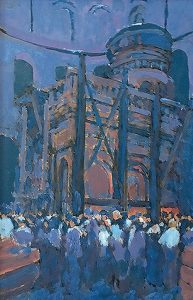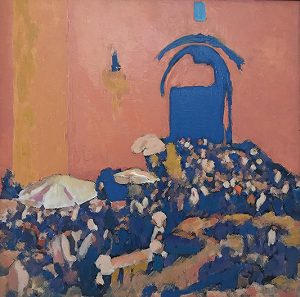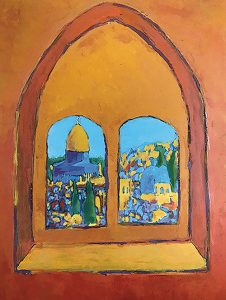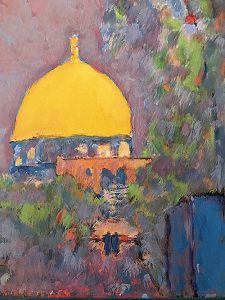New Artworks by Ali Qleibo
French Cultural Center, Jerusalem
May 19 – June 20, 2017
Jerusalem is beautiful. As we look at it, we could never imagine being aesthetically dissatisfied. The allure of Jerusalem inspires infinite images of the city. It is sacred, it is historic, it is magical. As I write or paint I appropriate my landscape: I inscribe my identity. The paintings, in effect, symbolize Palestinian landscapes, with the result being a total political appropriation of the visible world. The 22 oil paintings in “Window on Jerusalem” explore the relationship between experience and landscape, in which landscape is incorporated into a visual narrative.

Jerusalem is reproduced in my artworks not because reality as such is not sufficiently beautiful, but precisely on account of its beauty. Such also is the aim and object of my artworks; they do not correct reality, do not embellish it – they reproduce it and serve as a substitute for it. The narratives of landscape as the process by which the artist “reads” them are inherently political. As an artist and academician I not only interpret the selected landscapes, but in addition, everywhere I look I encounter a pre-interpreted landscape, or a landscape made legible. This is due not only to the interpretations and constructions of other Palestinian and orientalist discourses that have left their marks on the landscape, but also to the fact that I seek to reach an understanding of every landscape I come across in the context of all the other real, written, and photographed landscapes that have been previously experienced. This discursive view of representation alerts us to the extent to which painting can be thought of as a language, but we can see it as such at least to the extent that it is not simply an “analogue of reality” but rather an “iconic code” which one needs to be trained to recognize and read.
The narratives mobilized to make sense of Jerusalem’s landscape both help to create and are structured around the sense of identity, and it is through this dialectic interrelationship that the artistic expression acquires its sense of place and, consequently, produces the artist’s individual sense of identity.

Among the first colors to emerge from my palette are the hues of blue and pink ochre inspired by our landscapes. Throughout, my works declare blue. As my paintings acquire an increased substance, which in turn inspires and provokes the aggressiveness of the palette knife, brush, and cotton cloth, the visceral equation of impasto and blue becomes more integral to the artwork. The word “impasto” best describes my painting technique. The term refers to accumulations of paint on the surface of a canvas, often textured so that they catch the light.

This phenomenology of paint is most obviously realized in the large-size landscape paintings. The current series marks a major feature in my artistic production: the insistence on figuration allows me to acknowledge overtly the physiognomic basis of my painterly style, its source in the gestures of the body. Even as I move to an imagery of abstract landscapes, individual strokes and gestures developed in the earlier sketches continue to carry by allusion and recollection their sense of local color inspired by Palestinian landscape: just as the recurring blue and ochre pink proclaims my political identity as Palestinian with deep roots in the land. My paintings and writing in this sense are quintessentially nationalistic and a political confirmation and appropriation of the Palestinian identity of our Quds al-Sherif.

In Jerusalem, timeless awareness requires time. Time requires timeless awareness. In “Window on Jerusalem” my vision is intensely personal. Nostalgia, longing, and an unfathomable sense of loneliness envelop Jerusalem in a halo of huzon – sublime melancholy; a bittersweet refrain whose echo reverberates behind each painting. The energy overflows into art. The sensation coalesces into narratives that dissolve into pigments of light and shadow. The image solidifies into lines, volumes, and color. The feelings become a painting.
The paintings can be viewed at the French Cultural Center in Jerusalem, located on Salah el-Din Street. Opening hours are daily from 10:00 to 13:00, and from 14:00 to 18:00, except on Fridays and Sundays.

